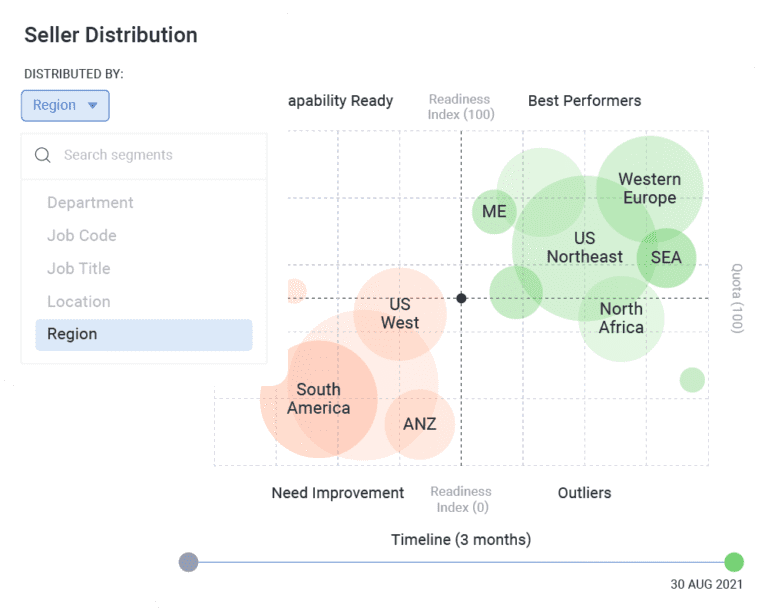From selling skills and customer satisfaction to sales and revenue, there are plenty of sales activity metrics to keep you busy. But which are actually accurately measuring sales productivity and effectively monitoring your team’s performance?
Here’s how to measure key sales performance metrics (and how to avoid common mistakes).
What are sales productivity metrics?
Sales productivity metrics are data points you use to track your team’s successes and impact on revenue. Depending on your organization and industry, different metrics like monthly revenue, number of employees, win rates, time-to-first-deal, etc. might be part of the equation.
Types of sales productivity metrics
No matter the sales org or industry, there are two basic kinds of sales productivity metrics: leading and lagging.
Leading indicators, such as customer satisfaction, help predict future performance and sales.
Lagging indicators, such as revenue numbers, help explain what happened in the past.
Naturally, you need a good mix of leading and lagging indicators to properly measure sales rep productivity.
Choosing key sales performance metrics
Key sales performance metrics look a little different for each company. You want to measure key performance indicators (KPIs) and revenue outcomes, sure — but you also need data on how your unique processes and workflows are functioning. The trick is to choose metrics that create insight into four things:
What your reps did
How they did it
Why they did it
What were the results
With this information, you won’t just be able to monitor performance — you’ll be able to proactively improve it (and see those results reflected in real numbers).
4 essential sales productivity metrics to monitor
Ready to choose the sales productivity metrics you’ll keep an eye on? Don’t forget to include these essential benchmarks on your list:
#1: Average revenue
It makes sense that revenue is the primary measurement for sales productivity. Average revenue is a particularly helpful metric because it can be broken down in so many ways. Here are just a few examples:
How much money does the average customer bring to your business? What’s the difference between current and new customers in terms of revenue?
How much is your product or service worth? Do you have a bestseller? Are certain offerings lagging while others make incredible revenue?
Which sales reps bring in the most money?
#2: Market penetration
If you want to know how great your sales reps are at getting products and services in the right hands, one place to start is market penetration. This metric measures how much of the available market you “own” through your offerings.
But what does that look like on paper? Check out this market penetration formula:
The higher your market penetration, the better your sales reps are doing. They might even have an easier time making sales if your brand’s reputation and offerings are already well-known.
#3: Retention rate
Sales rep productivity metrics aren’t just about the sales themselves. These numbers also reflect vital elements of the customer experience and, in turn, how many future sales can be created by a good initial sale. That’s why customer retention rate is another key metric to track.
Here’s how to determine retention rates:
- Choose a time frame.
- Find the number of customers at the start of that time frame. (Call this “S.”)
- Find the number of customers at the end of that time frame. (Call this “E.”)
- Perform this calculation — E – S — to find the number of new customers. (Call this “N.”)
- Plug your numbers into this formula: [(E-N)/S] x 100. This is your customer retention rate.
#4: Sales rep habits
Which sales reps are making the most calls? Which are taking the most notes, sending the most emails, and pushing the most products or services per sale?
These habits might not tell a full story on their own — but compare them to sales data and you’re sure to find relevant patterns. For example, maybe a high number of notes correlates to a high number of sales because reps are better able to build real relationships when they keep track of customer information.
Whatever your research uncovers, be sure to track these sales rep productivity metrics regularly to monitor progress, intervene when necessary, and celebrate big wins.

How can monitoring sales productivity metrics increase sales performance?
Your first steps are to decide which key sales performance metrics to track, how often to gather data, and what you’ll do with this information. That’s when you’ll start seeing results.
Here’s a simplified look at how it works:
- You notice an issue. For example, say your sales productivity is slipping and you have a low average revenue per customer.
- You compare other metrics. You need to compare all your data points to see the full story. If n this way, you’ll uncover patterns — for example, maybe sales reps are pushing products or services that don’t make as much money.
- You implement targeted solutions. Now that you’ve seen the patterns, you can put effective tools, training, or processes into place. In this case, you might train reps to offer the right products or services at the right times — not just to increase revenue, but to boost retention, too.
- You track changes. Keep an eye on the same metrics you tracked before. If you see significant changes, your tactics are working; if not, it’s back to the drawing board.
The basis of this process is simple: Monitoring sales productivity metrics gives you the insight you need to identify gaps and fill them with the best possible solutions. Without this information, you’d be left guessing where your sales reps are struggling, what works and what doesn’t, whether your “fixes” actually fixed anything, and more.
3 mistakes to avoid while tracking sales productivity metrics
Tracking key sales performance metrics isn’t always easy. Here are a few mistakes to avoid (and how to do better):
Tracking the wrong things
Changing your tracking process
Failing to act
#1: Tracking the wrong things
Not every metric is equally helpful. It’s up to you to make sure you find the numbers that matter — and the best ways to track them. If you get caught up in the wrong metrics, you could end up with a skewed view of sales rep productivity, revenue, and more.
#2: Changing your tracking processes
Say you have a process for tracking a certain metric, and then you abruptly change course. The numbers gathered before the change aren’t comparable to those gathered after — which means you’ve wasted time and effort. When it comes to tracking key performance metrics, make sure to stay consistent in your processes, schedules, and more.
#3: Failing to act
Key sales performance metrics are just information. If you don’t use that information to make decisions and implement changes based on what you learned, you won’t get value from your data. That’s why it’s important to have a plan of action — because it’s the best way to turn metrics into actionable insights.
Conclusion
Wondering how to measure sales rep productivity when there are so many metrics to consider, numbers to juggle, and mistakes to avoid? The key is to have a good foundation — and that all starts with a single revenue productivity platform. When performance and the processes that track it are in the same place, it’s much easier to create a clear, streamlined story of your sales successes.
Get the most out of every sales rep
Ready to find out how a single solution can help you track and improve sales rep performance?
Get a Demo
This post was originally published in February 2023 and was updated in October 2023.







